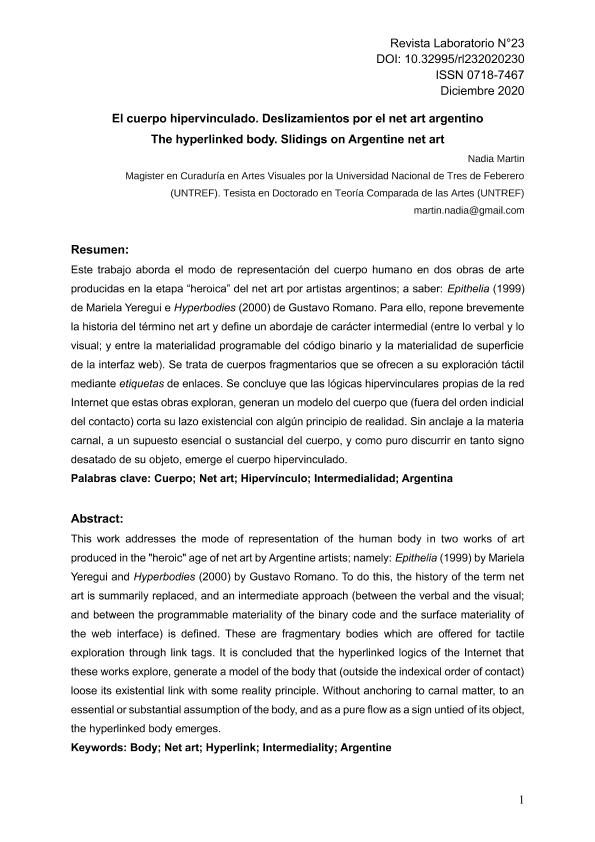Mostrar el registro sencillo del ítem
dc.contributor.author
Martin, Nadia Soledad

dc.date.available
2022-10-12T19:03:43Z
dc.date.issued
2020-12
dc.identifier.citation
Martin, Nadia Soledad; El cuerpo hipervinculado: Deslizamientos por el net art argentino; Universidad Diego Portales. Facultad de Comunicación y Letras. Escuela de Literatura Creativa; Laboratorio; 23; 12-2020; 1-20
dc.identifier.issn
0718-7467
dc.identifier.uri
http://hdl.handle.net/11336/172783
dc.description.abstract
Este trabajo aborda el modo de representación del cuerpo humano en dos obras de arte producidas en la etapa “heroica” del net art por artistas argentinos; a saber: Epithelia (1999) de Mariela Yeregui e Hyperbodies (2000) de Gustavo Romano. Para ello, repone brevemente la historia del término net art y define un abordaje de carácter intermedial (entre lo verbal y lo visual; y entre la materialidad programable del código binario y la materialidad de superficie de la interfaz web). Se trata de cuerpos fragmentarios que se ofrecen a su exploración táctil mediante etiquetas de enlaces. Se concluye que las lógicas hipervinculares propias de la red Internet que estas obras exploran, generan un modelo del cuerpo que (fuera del orden indicial del contacto) corta su lazo existencial con algún principio de realidad. Sin anclaje a la materia carnal, a un supuesto esencial o sustancial del cuerpo, y como puro discurrir en tanto signo desatado de su objeto, emerge el cuerpo hipervinculado.
dc.description.abstract
This work addresses the mode of representation of the human body in two works of art produced in the "heroic" age of net art by Argentine artists; namely: Epithelia (1999) by Mariela Yeregui and Hyperbodies (2000) by Gustavo Romano. To do this, the history of the term net art is summarily replaced, and an intermediate approach (between the verbal and the visual; and between the programmable materiality of the binary code and the surface materiality of the web interface) is defined. These are fragmentary bodies which are offered for tactile exploration through link tags. It is concluded that the hyperlinked logics of the Internet that these works explore, generate a model of the body that (outside the indexical order of contact) loose its existential link with some reality principle. Without anchoring to carnal matter, to an essential or substantial assumption of the body, and as a pure flow as a sign untied of its object, the hyperlinked body emerges.
dc.format
application/pdf
dc.language.iso
spa
dc.publisher
Universidad Diego Portales. Facultad de Comunicación y Letras. Escuela de Literatura Creativa
dc.rights
info:eu-repo/semantics/openAccess
dc.rights.uri
https://creativecommons.org/licenses/by-nc-sa/2.5/ar/
dc.subject
Cuerpo
dc.subject
Net art
dc.subject
Intermedialidad
dc.subject.classification
Otras Lengua y Literatura

dc.subject.classification
Lengua y Literatura

dc.subject.classification
HUMANIDADES

dc.subject.classification
Otras Artes

dc.subject.classification
Arte

dc.subject.classification
HUMANIDADES

dc.subject.classification
Otras Comunicación y Medios

dc.subject.classification
Comunicación y Medios

dc.subject.classification
CIENCIAS SOCIALES

dc.title
El cuerpo hipervinculado: Deslizamientos por el net art argentino
dc.title
The hyperlinked body: Slidings on Argentine net art
dc.type
info:eu-repo/semantics/article
dc.type
info:ar-repo/semantics/artículo
dc.type
info:eu-repo/semantics/publishedVersion
dc.date.updated
2022-10-11T19:39:01Z
dc.journal.number
23
dc.journal.pagination
1-20
dc.journal.pais
Chile

dc.journal.ciudad
Santiago de Chile
dc.description.fil
Fil: Martin, Nadia Soledad. Consejo Nacional de Investigaciones Científicas y Técnicas; Argentina. Universidad Nacional de Tres de Febrero. Instituto de Investigaciones en Arte y Cultura "Dr. Norberto Griffa"; Argentina
dc.journal.title
Laboratorio
dc.relation.alternativeid
info:eu-repo/semantics/altIdentifier/url/https://revistalaboratorio.udp.cl/index.php/laboratorio/article/view/232
Archivos asociados
